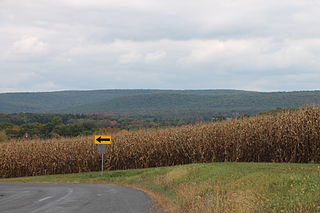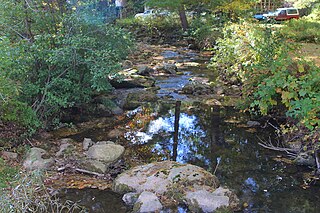
Scotch Run is one of the main tributaries of Catawissa Creek in Columbia County, Pennsylvania, in the United States. It is approximately 7.8 miles (12.6 km) long and flows through Beaver Township and Main Township. The stream's watershed has an area of 9.10 square miles (23.6 km2). The stream is infertile and acidic. It is 7.2 feet (2.2 m) wide in its upper reaches and 17.0 feet (5.2 m) wide in its lower reaches. The main rock formations in the watershed include the Mauch Chunk Formation, the Pocono Formation, the Pottsville Formation, and the Spechty Kopf Formation. The main soils include Leck Kill soil and Hazleton soil. It flows between Nescopeck Mountain and McCauley Mountain.

Furnace Run is a tributary of Catawissa Creek in Columbia County, Pennsylvania, in the United States. It is approximately 2.5 miles (4.0 km) long and flows through Catawissa Township and Main Township. The stream is the last named tributary to enter Catawissa Creek before its mouth. The stream's watershed has an area of 2.82 square miles (7.3 km2). The main rock formations are the Pottsville Group and the Mauch Chunk Formation. The stream itself is considered to be a high quality coldwater fishery and Class A Wild Trout Waters.

Fisher Run is a tributary of Catawissa Creek in Columbia County, Pennsylvania, in the United States. It is approximately 2.9 miles (4.7 km) long and flows through Main Township and Beaver Township. The stream is impaired by acid mine drainage. It is considered to be a high-quality coldwater fishery and Class A Wild Trout Waters. The watershed of the stream has an area of 3.03 square miles (7.8 km2).
Mine Gap Run is a tributary of Catawissa Creek in Columbia County, Pennsylvania, in the United States. It is approximately 1.5 miles (2.4 km) long and flows through Roaring Creek Township and Beaver Township. The watershed of the stream has an area of 0.92 square miles (2.4 km2). The stream is polluted and acidic. However, it is considered to be a coldwater fishery. The main rock formations in the stream's watershed are the Mauch Chunk Formation, the Spechty Kopf Formation, the Pocono Formation, and the Buddys Run Member of the Catskill Formation.

Long Hollow is a tributary of Catawissa Creek in Columbia County, Pennsylvania, in the United States. It is approximately 2.5 miles (4.0 km) long and flows through Roaring Creek Township and Beaver Township. The watershed of the stream has an area of 2.84 square miles (7.4 km2). The stream has a neutral pH and is considered to be a coldwater fishery. The main rock formations in the stream's watershed are the Mauch Chunk Formation, the Spechty Kopf Formation, the Pocono Formation, and the Buddys Run Member of the Catskill Formation.

Klingermans Run is a tributary of Catawissa Creek in Columbia County, Pennsylvania, in the United States. It is approximately 2.4 miles (3.9 km) long and flows through Roaring Creek Township and Beaver Township. The watershed of the stream has an area of 1.78 square miles (4.6 km2). The stream is considered to be a High-Quality Coldwater Fishery and Class A Wild Trout Waters. The main rock formations in the stream's watershed are the Mauch Chunk Formation and the Pocono Formation and the main soils are the Leck Kill soil and the Hazleton soil.

Cranberry Run is a tributary of Catawissa Creek in Columbia County, Pennsylvania, in the United States. It is approximately 2.0 miles (3.2 km) long and flows through Beaver Township. The watershed of the stream has an area of 1.83 square miles (4.7 km2). The stream is considered to be a Coldwater Fishery. The main rock formations in the stream's watershed are the Mauch Chunk Formation and the Pocono Formation and the main soils are the Leck Kill soil and the Hazleton soil.
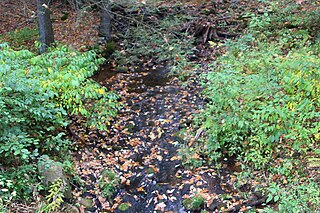
Crooked Run is a tributary of Catawissa Creek in Schuylkill County, Pennsylvania, in the United States. It is approximately 4.4 miles (7.1 km) long and flows through North Union Township. The watershed of the stream has an area of 4.24 square miles (11.0 km2). The stream is considered to be a High-Quality Coldwater Fishery and Class A Wild Trout Waters. However, it is impaired by atmospheric deposition. The main rock formations in the stream's watershed are the Mauch Chunk Formation and the Pocono Formation and the main soils are the Leck Kill soil and the Hazleton soil.

Raccoon Creek is a tributary of Tomhicken Creek in Luzerne County and Schuylkill County, in Pennsylvania, in the United States. It is approximately 3.3 miles (5.3 km) long and flows through Black Creek Township in Luzerne County and North Union Township in Schuylkill County. The watershed of the stream has an area of 2.67 square miles (6.9 km2). The stream is considered to be a High-Quality Coldwater Fishery and Class A Wild Trout Waters. The main rock formations in the stream's watershed are the Mauch Chunk Formation and the Pottsville Formation and the main soil is the Leck Kill soil.

Little Crooked Run is a tributary of Tomhicken Creek in Schuylkill County, Pennsylvania, in the United States. It is approximately 1.7 miles (2.7 km) long and flows through North Union Township. The watershed of the stream has an area of 1.22 square miles (3.2 km2). The stream is considered to be a High-Quality Coldwater Fishery and Class A Wild Trout Waters. The main rock formations in the stream's watershed are the Mauch Chunk Formation and the Pottsville Formation and the main soil is the Hazleton soil.
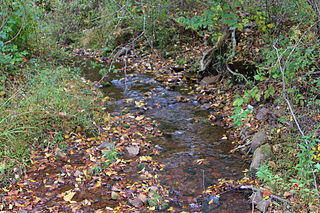
Stony Run is a tributary of Little Catawissa Creek in Schuylkill County, Pennsylvania, in the United States. It is approximately 2.2 miles (3.5 km) long and flows through Union Township. The watershed of the stream has an area of 2.24 square miles (5.8 km2). The stream is polluted and acidic. However, it is considered to be a coldwater fishery. The main rock formations in the stream's watershed are the Mauch Chunk Formation and the Pocono Formation. The main soils in the watershed are the Leck Kill soil and the Hazleton soil. No fish inhabit the stream.
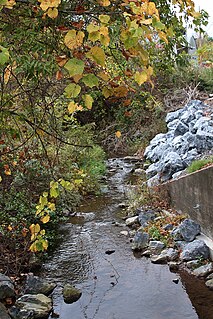
Dark Run is a tributary of Catawissa Creek in Schuylkill County, Pennsylvania, in the United States. It is approximately 4.3 miles (6.9 km) long and flows through Union Township. The watershed of the stream has an area of 4.55 square miles (11.8 km2). The stream is considered to be a High-Quality Coldwater Fishery and Class D Wild Trout Waters. Eight species of fish inhabit the stream. The main rock formations in the stream's watershed are the Mauch Chunk Formation and the main soil is the Leck Kill soil. The stream has several unnamed tributaries.

Rattling Run is a tributary of Catawissa Creek in Schuylkill County, Pennsylvania, in the United States. It is approximately 2.4 miles (3.9 km) long and flows through East Union Township. The watershed of the stream has an area of 2.28 square miles (5.9 km2). The stream is considered to be a High-Quality Coldwater Fishery and Class A Wild Trout Waters. Three species of fish inhabit the stream. The main rock formations in the stream's watershed are the Mauch Chunk Formation and the Pottsville Formation and the main soils are the Leck Kill soil and the Hezleton soil. The stream has two unnamed tributaries.

Davis Run is a tributary of Catawissa Creek in Schuylkill County, Pennsylvania, in the United States. It is approximately 1.2 miles (1.9 km) long. The watershed of the stream has an area of 2.86 square miles (7.4 km2). The stream is considered to be a High-Quality Coldwater Fishery and Class A Wild Trout Waters. Six species of fish inhabit the stream, including brown trout and brook trout. The main rock formations in the stream's watershed are the Mauch Chunk Formation and the Pottsville Formation and the main soils are the Leck Kill soil and the Hezleton soil. The stream has two unnamed tributaries and a lake known as the Pumping Station Reservoir.

Messers Run is a tributary of Catawissa Creek in Schuylkill County, Pennsylvania, in the United States. It is approximately 5.2 miles (8.4 km) long and flows through Kline Township and East Union Township. The only named tributary of the stream is Negro Hollow, but it has two unnamed tributaries. The creek has some alkalinity, but is slightly acidic. The main rock formations in the watershed of it are the Mauch Chunk Formation and the Pottsville Formation. The main soils in the watershed are the Leck Kill soil and the Hazleton soil.

Negro Hollow is the only named tributary of Messers Run in Schuylkill County, Pennsylvania, in the United States. It is approximately 1.7 miles (2.7 km) long and flows through Delano Township, Kline Township, and East Union Township. The watershed of the stream has an area of 1.57 square miles (4.1 km2). The stream is considered to be a High-Quality Coldwater Fishery and Class A Wild Trout Waters. Two species of fish inhabit the stream, including brook trout. The main rock formations in the stream's watershed are the Mauch Chunk Formation and the Pottsville Formation and the main soils are the Leck Kill soil and the Hezleton soil. The stream has one unnamed tributary.
Spies Run is a tributary of Catawissa Creek in Schuylkill County, Pennsylvania, in the United States. It is approximately 1.0 mile (1.6 km) long and flows through East Union Township. The stream has a pH that is fairly close to neutral. The stream is in the United States Geological Survey quadrangle of Conyngham. Trout naturally reproduce in it.

Mill Creek is a tributary of Roaring Creek in Columbia County, Pennsylvania, in the United States. It is approximately 3.1 miles (5.0 km) long and flows through Roaring Creek Township and Locust Township. The watershed of the creek has an area of 4.98 square miles (12.9 km2). The creek is considered to be a High-Quality Coldwater Fishery and Class A Wild Trout Waters. Numerous species of macroinvertebrates inhabit it. The creek was named from the presence of a mill.





